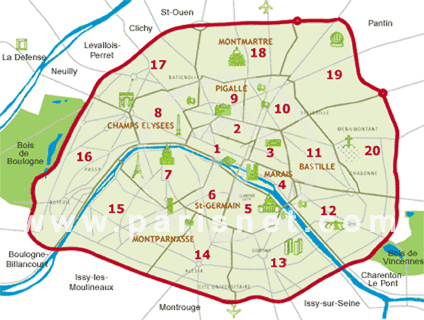 After reading some classic urban planning texts I can't help but continue to ruminate about what makes this city so different, and effective, compared to the younger version of cities I'm used to in North America.
After reading some classic urban planning texts I can't help but continue to ruminate about what makes this city so different, and effective, compared to the younger version of cities I'm used to in North America. Some key points first: There is no "downtown" or "Central Business District", the city is actually 20 mini-districts that spiral outwards from approximately The Louvre. You won't notice walking from one to the other, the borders are sometimes physical barriers (e.g. water), and each one shouldn't be thought of in the same way Canadians' think of the GTA or Greater Vancouver Area, they all collectively make Paris as its known. Each arrondissment (as they are called) takes up some degree of responsibility for its citizens, managing public affairs such as garbage collection, street cleaning, park maintenance, language classes, immigration services, public pools...pretty much everything day-to-day. The larger affairs, like getting accepted through immigration, work permits or legal affairs are dealt with through the larger over-arching 'provincial' municipality, Ile de France. And for arguments sake I'll let you know those small towns surrounding the city border are no more suburban than inside the city: similar densities exist.
What is so different?
.JPG) |
| Text-book mixed uses in Paris 15th Arrd. |
Non-mixed uses like what exists in even the best Canadian neighborhoods, e.g. areas designated specifically for stores, others for industry, others for houses, others for town-houses, for high-rises, creates huge vacuums of space, areas that are unwalkable, uncomfortable or simply unlivable. I think of mid-rise, nice condominiums in Guelph's west end that have been vacant for years after completion: the planners pictures don't match the reality that someone wants to walk to work, school, groceries, and for play (kids=day, adults=night). After the developers' initial payments of installing suburban sidewalks, roads, and piping needs to be replaced, do you think the amount of people living on one suburban street can cover the cost? not even close. It is the people in the sustainable parts of town that need to foot the bill.
Solutions exist, can and are being implemented to help fill this vacuum of space, and to make our cities more economically feasible and enjoyable in general. To do this cities' must be thought of as compartments of areas where humans live, not compartments of numbers that require only one thing at one given time. We are not discreet in our movement, we are continuous, and our construction patterns should be reflective of this. Solutions can be thought of based upon those people in their district seeing how their ideal city would be: not the city in the imagination of a planner who was born, raised, and probably will die in a suburb.
No comments:
Post a Comment